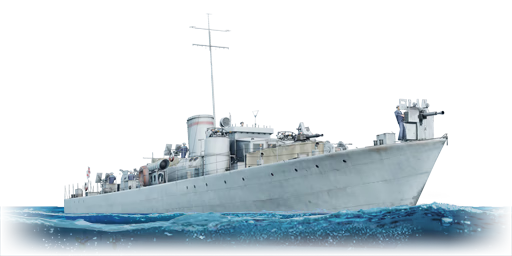



The SGB Grey Fox is a British motor gun boat. It was introduced in Update 1.83 "Masters of the Sea" as part of the British fleet closed beta test.
The SGB (Steam Gun Boat) Grey Fox, pennant number S304, was a gun boat built for the Royal Navy's coastal forces during the early stages of World War II. While limited in historical quantities, the Grey Fox is a formidable boat within the game. This is thanks to a plentiful variety of armaments covering the steam-powered boat from prow to stern.
With few cons, this SGB engages with ease most boats that are equally sized and smaller than her. Although, the large hull and not excellent top speed makes her the perfect target for destroyers, frigates, and gunboats. After learning how to handle these limitations, captains are likely to master this well-armed boat.
| Belt | Belt filling | Armor penetration (mm) at a distance: | |||||
|---|---|---|---|---|---|---|---|
| 10 m | 100 m | 500 m | 1000 m | 1500 m | 2000 m | ||
| HEF/AP-T/HEF/AP-T | 60 | 57 | 50 | 43 | 38 | 34 | |
| HEF/HEF/HEF/AP-T | 60 | 57 | 50 | 43 | 38 | 34 | |
| AP-T/AP-T/AP-T/HEF | 60 | 57 | 50 | 43 | 38 | 34 | |
| Ammunition | Type | Armor penetration (mm) at a distance: | |||||
|---|---|---|---|---|---|---|---|
| 100 m | 1000 m | 2000 m | 3000 m | 4000 m | 5000 m | ||
| HE | 12 | 10 | 9 | 8 | 7 | 7 | |
| Shrapnel | 11 | 10 | 9 | 8 | 7 | 7 | |
| Belt | Belt filling | Armor penetration (mm) at a distance: | |||||
|---|---|---|---|---|---|---|---|
| 10 m | 100 m | 500 m | 1000 m | 1500 m | 2000 m | ||
| HEF-T/AP-T | 34 | 32 | 26 | 21 | 18 | 16 | |
| Belt | Belt filling | Armor penetration (mm) at a distance: | |||||
|---|---|---|---|---|---|---|---|
| 10 m | 100 m | 500 m | 1000 m | 1500 m | 2000 m | ||
| AP/HEI/T | 24 | 24 | 21 | 18 | 16 | 15 | |
4 × 1123/1323 lbs Type M Mark I moored contact mine











Seakeeping |
|---|
Unsinkability | |
|---|---|
Firepower | ||
|---|---|---|